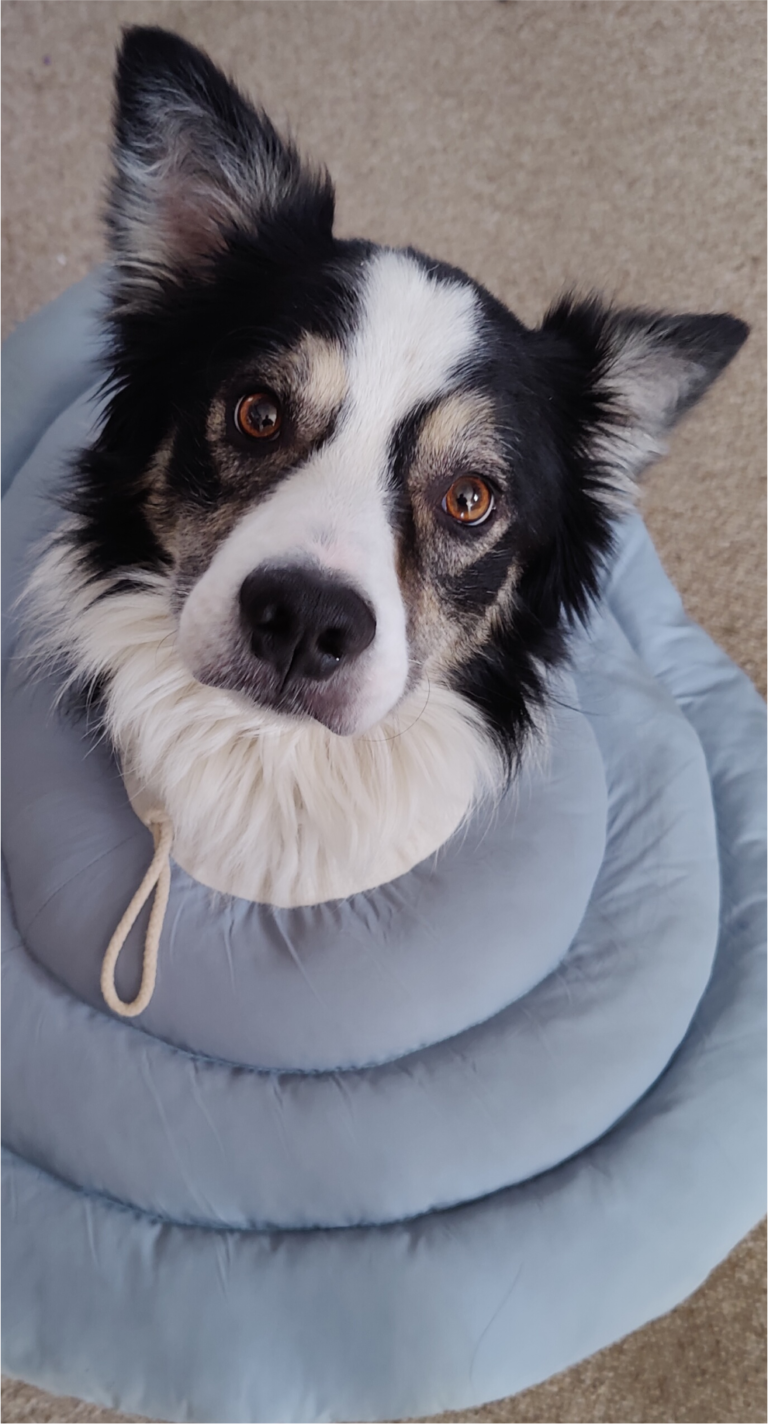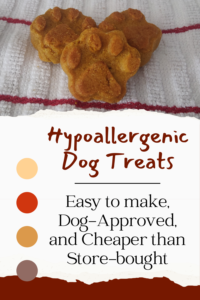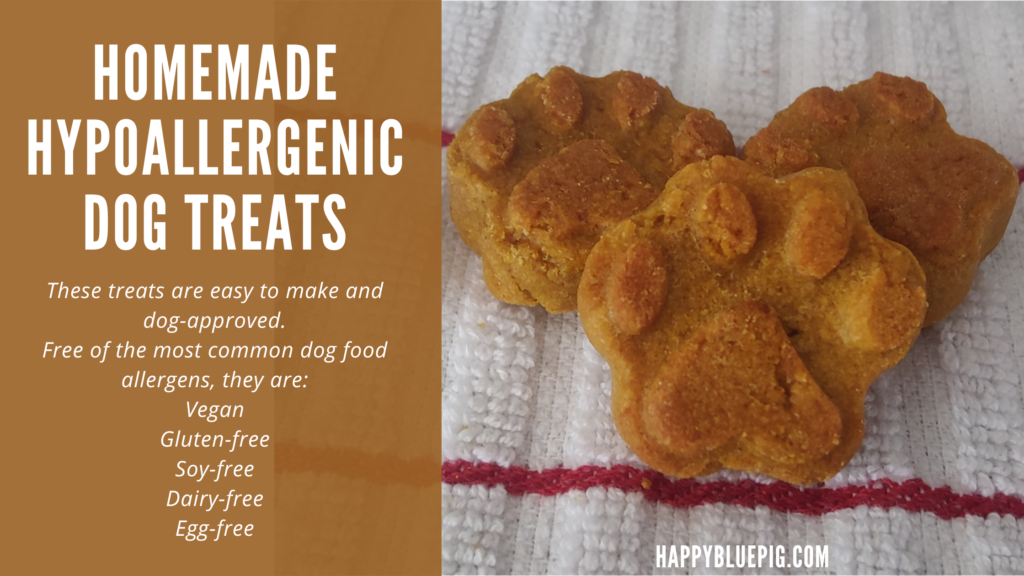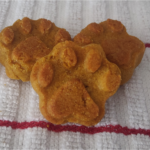This year, our dog developed a food allergy, and we learned that can be really expensive. Between medications and special foods, it adds up fast. I went through all his treats, and he was left with one kind he could eat. In researching other treats we could buy for him, I was shocked by the prices! We’ve made homemade dog treats before, and our dog loved them so much that he would choose them over any other treat in our doggy taste tests. With a bit of trial and error, I’ve adapted it to meet his new needs and avoid common dog food allergies. It’s quick, easy, and dog-approved. Whether or not you have an allergy pup like mine, I think your four-legged friends will love this recipe!
This post may contain affiliate links, which means I’ll receive a commission if you purchase through my links, at no extra cost to you. Please read full disclosure for more information.

Common Dog Food Allergens
If you’ve just found out your dog may have food allergies, it can be a bit overwhelming, especially if you are doing an elimination diet. An elimination diet is when you completely remove several possible allergens from the diet for several weeks. Then, one at a time, you reintroduce the potential allergens to determine which are causing a reaction. BMC Veterinary Research published an article with findings of the most common food allergens for dogs. This has helped me determine what order I wanted to reintroduce foods. I started with the least common allergens they listed and worked up the list. Here are the 16 allergens they found and their frequency:
About this study:
This study looked at 297 dogs, and each dog included in the study had at least one food allergy. The percentages listed above are the percentage of the 297 dogs that had each particular food allergy.
Elizabethan Style Donut Collar
So, in addition to the diet change, our dog also needed a soft cone to protect his skin. We needed to make sure he couldn’t reach his legs, as that’s where some of his hot spots were. This Elizabethan donut collar has worked well for us. He can get to the very tip of his tail, but that’s about it. And he sure looks pretty comfy while he’s napping!
Ways to Adapt a Recipe for Your Dog
My dog loved the treat recipe I’d used in the past, but the treats included wheat flour and eggs, both of which were now off limits for my dog. Fortunately, I’ve had some experience adapting human recipes for family members with diabetes, gluten-free diets, egg and soy allergies, and alpha-gal syndrome. I was 100% sure we could make a few easy switches and have a delicious treat.
Gluten-free
If you’ve never wandered into the gluten-free section at your grocery store, take a look. There are so many different kinds of gluten-free flours and baking mixes these days. I like to use almond flour and oat flour for human recipes, and I chose oat flour for these dog treats as dogs should only have almond in limited quantities. Oat flour is safe for your dog, and the end product has a similar texture as with regular flour. These dog treats can be broken in half without becoming crumbly. Most importantly, oat flour is just fine for your dog to eat, and it’s not a common dog allergen!
Egg-free
There are actually many substitutions for eggs in baking, but I have two favorites: egg-replacer and applesauce. Both of these options are safe for your dog to eat as part of a treat recipe. Just make sure to use unsweetened applesauce; your dog does not need added sugar.
Egg-replacer
If you are not familiar with egg-replacer, it makes baking without eggs very easy. It is a powder that, when mixed with a bit of water, can replace eggs in your baked goods. It’s vegan, shelf-stable and it lasts a long time, so I always keep it on hand. If I run out of eggs while baking, no problem! And, as an added bonus, it’s one product you’ll buy for your allergy pup that’s actually cheaper! A pack is the equivalent of almost 3 dozen eggs. It would cost over $7 to buy 3 dozen eggs right now in my local grocery store. Bob’s Red Mill Egg Replacer costs less than $5!
Applesauce
To use applesauce, replace one egg with about 1/4 cup of unsweetened applesauce. If you are looking to adapt other recipes, be aware that this substitution may take a bit more trial and error. You may have to reduce the amount of liquid in your recipe or increase baking time.
Other possible substitutions
If your dog cannot have peanut butter (or a family member has a severe peanut allergy), cashew butter, hazelnut butter, and almond butter are safe for your dog to eat too. Just be aware that almonds can cause digestive upset in some dogs.
If you don’t want to use oat flour, other gluten-free flours that are good for dog treats are sorghum flour and chickpea flour.
To replace pumpkin puree, you could make your own puree from several different ingredients. You could use squash, carrot, sweet potato, zucchini, or banana. Depending on the consistency of your puree, you may need to adjust liquid in your recipe.

What You Need to Make Your Own Hypoallergenic Dog Treats
Ingredients
Oat Flour
Purchase oat flour, or grind your own from rolled oats using a blender or food processor. Be aware, it can take a long time to grind and you may not get a truly fine consistency. I always buy it, because I can’t stand to listen to my dog bark at the food processor for that long!
Peanut butter
As with all baking for dogs, always make sure that you use a natural peanut butter that does NOT contain xylitol. Xylitol is toxic to dogs.
Egg-Replacer or Applesauce
I’d recommend just purchasing Bob’s Red Mill Egg Replacer, but if you don’t like that idea you can also make these treats with unsweetened applesauce instead.
Pumpkin puree
When you buy pumpkin puree, make sure you are buying pumpkin puree and not pumpkin pie filling. Pumpkin pie filling has added ingredients that are not good for your dog. You want Pumpkin Puree, which will have only one ingredient: Pumpkin!
Other Supplies: Fun Molds
Of course, you don’t need fancy molds to make a tasty dog treat. I’m sure that my dog doesn’t care in the slightest what the treats look like. In fact, he already knows when I’m mixing that I’m baking for him, and he’ll beg for a taste of the batter. I still love having a cute dog treat, so I use dog bone and paw print molds! These molds are very affordable, and since they are silicone, they are easy to use and clean.

Storing your treats
Store your treats in an airtight container or bag for a week or more.
In our house, a batch doesn’t last more than a week. Just look at that sweet face begging for a taste of the batter before I even got them baked! Even with his soft collar, he’s still cute as a button.

If you bake these treats for your 4-legged friends, please leave me a comment or email me a picture of your pup begging for treats. I hope this recipe gets you lots of tail wags and begging puppy-dog eyes!
For more ideas, check out my Money-Saving Recipes!
Hypoallergenic Dog Treats
Equipment
- silicone molds
Ingredients
- 2 cups oat flour
- 3 Tbsp peanut butter (must not contain xylitol)
- 1/2 cup pumpkin puree
- 2 Tbsp Bob's Red Mill Egg Replacer (can substitute 1/2 cup unsweetened applesauce instead)
Instructions
- Mix 2 Tablespoons of Egg replacer with 4 Tablespoons of water, and let sit for 1 minute. (If you do not wish to use egg replacer, then omit the egg replacer AND the water, and simply use 1/2 cup unsweetened applesauce instead.)
- Add oat flour, peanut butter, and pumpkin puree. Mix until well combined.
- Press batter into silicone molds. Do not overfill past the top of the mold.
- Bake at 350 degrees Fahrenheit for 30 minutes. (If you used the applesauce substitution, you may need additional baking time)
- Remove from molds onto cooling rack or towel, and allow to cool before feeding them to your pup.
Notes




